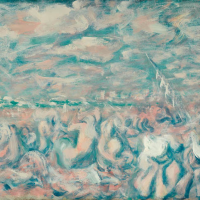5. WILLIAM DOBELL

A sincere artist is not one who makes a faithful attempt to put on to canvas what is in front of him, but one who tries to create something which is, in itself, a living thing.
Sir William Dobell
In Bondi Beach Sir William Dobell reveals his adeptness in capturing the enduring subject of his artistic interest, people. Unlike many Australian mid-century Modernists who took the landscape as a point of departure in their work, Dobell was ultimately a figurative painter. His true passion lay in conveying the personality and character of human subjects through his particular, highly expressive manner of representation that skewed reality. This sometimes proved too radical for the conservative post war mentality that existed within the Australian art world, as the infamous backlash to his Archibald Prize winning portrait of Joshua Smith proved in 1944. Yet Dobells reputation was built upon the uniqueness and originality of his vision, which ultimately led him to become one of the nations most celebrated and memorable artists.
Fundamentally his interest is in people rather than places, and since people vary only marginally from place to place, he finds suitable material wherever he happens to be.1 In Bondi Beach Dobells interest in people becomes intimately tied with his representation of place, as the two combine to bestow a sense of personality upon this iconic beachside location. This is conveyed through the artists virtuosic depiction of heaving human forms, swirling skies, and the seas distant white capped peaks. His handling of these separate elements with the same gestural, sweeping brushstrokes and a restricted colour palette creates a satisfying aesthetic cohesion within the painting, successfully evoking the heady, fleshy bustle of a busy day on a hot beach.
The most clearly defined figures within this scene that brims with life are the pair in the lower right foreground. With heads rested upon hands, they turn to look at one another with a playful, conspiratorial air. This simple gesture contributes to the paintings celebratory evocation of Sydneys urban beach culture in the 1960s, which perhaps found its ultimate expression on the yellow sands of Bondi.
The present work is related to Dobells other painting Beach Carnival c1960 that was commissioned by Her Majesty the Queen and H.R.H the Duke of Edinburgh for Windsor Castle. In this painting, Dobell sought to create something quintessentially Australian, and was captivated by an upside-down newspaper photograph of a beach scene which depicted a mass of human bodies immersed in the sun, sea and surf.2 This may well have formed the conceptual leaping-off point for related paintings such as the present work, and Bondi Beach 1961, in the collection of the Bendigo Art Gallery. Certainly the rhythmically structured compositions, loose handling of paint and the overall sense of human and natural spectacle are characteristics shared in Dobells beach scenes of this period.
The treatment of light and flesh in the present work reveal the influence of the Impressionists, particularly Renoir (1841-1914), one of the artists Dobell studied at length during his period living in London between 19291938. While his depiction of urban life and social mores of his bathing subjects contains a nod to Daumier (1808-1879) and Hogarth (1697-1764) minus their satirical sting.3
Yet while absorbing lessons from past masters, Dobells highly memorable aesthetic is completely his own. Through it he conveys the essence of place in Bondi Beach, and the people who bring it to life.
Footnotes
1. Gleeson, J., William Dobell, Thames and Hudson, London, 1964, p.9
2. ibid p.107
3. ibid p.7
Marguerite Brown MA ArtCur